Ecological management in HuertAula Cantarranas
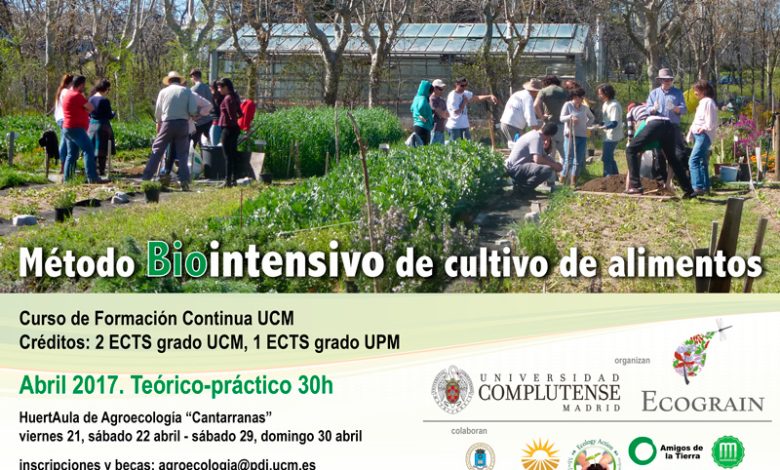
As Daniel told us in the previous post (Community garden in Madrid: «HuertAula CANTARRANAS»), this ecological garden is the largest of those that make up the Network of community urban gardens of the Community of Madrid (ReHdMad !)
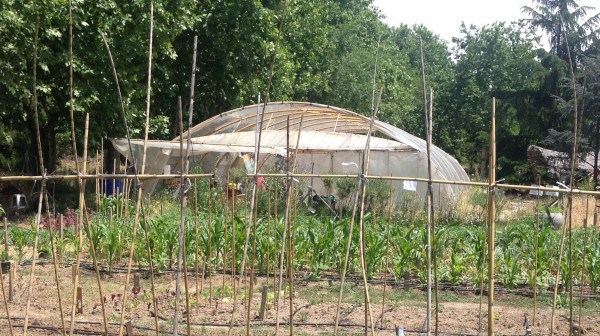
In addition to the educational and social work that we already talked about in the other article (it welcomes a multitude of groups and work groups: job rehabilitation, social integration of people with disabilities, schools…), it has an important mission in practice and dissemination of Ecological Agriculture.
In this post I will tell you a little about what and how it is grown in the HuertAula CANTARRANAS, summarizing the most important points of ecological management in this urban garden. I hope it works for you!
Seeds and nurseries: the greenhouse of CANTARRANAS
It all starts in the greenhouse, where most of the crops that are later planted in the terraces are started in all kinds of nurseries or seedlings.
In addition to providing seedlings and seedlings to the Cantarranas orchard, this greenhouse houses orchard seedbeds that are found throughout the city. The community gardens request it and HuerAula gives them the space. Each person or association that uses it is responsible for their seedbed, so each one carries their own seed and substrate. So that there is no type of confusion, they place an identification label with the name or initials of the orchard to which each seedbed belongs, the planting date and what each one contains, as you can see by clicking on these photos:
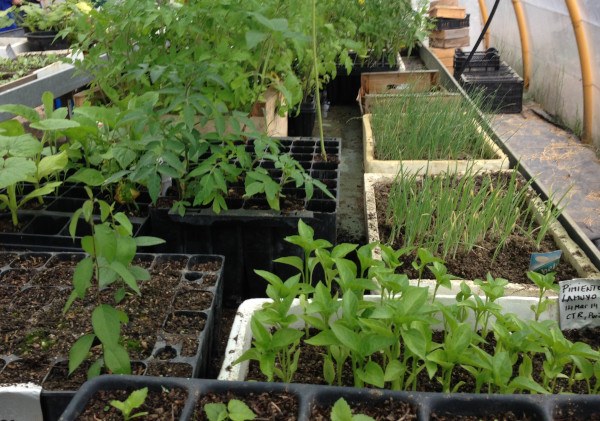
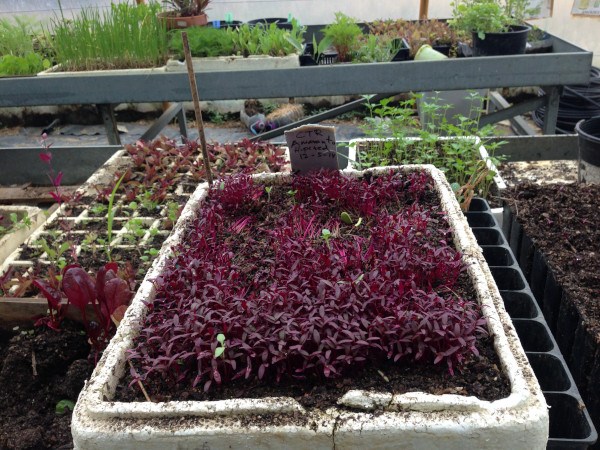
The seeds used are organic seeds, mostly local or traditional varieties.They come from several places:
- From the garden itself, where some seeds are collected directly from the plants. In the photo below you can see the celery marked with pink ribbons, which is the sign used in HuertAula to indicate that the crop should not be harvested yet because it is waiting to collect its seed.
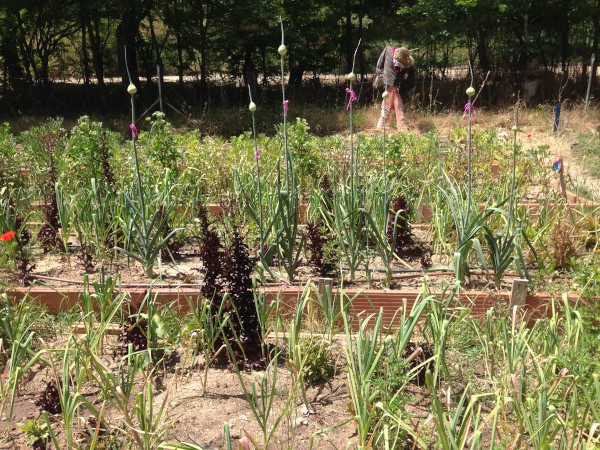
- From other orchards of the ReHdMad! with which seed exchanges are made.
- From the seed exchange bank that is in the Matadero Madrid cultural space and that is managed by the cooperative of ecological products ECOSECHA.
- From INIA (National Institute of Agricultural and Food Research and Technology), with which they collaborate. This organism yields seeds to the ReHdMad! and in the HuertAula greenhouse these seeds are reproduced and multiplied. A part is returned to INIA so that they can be analyzed and included in the National Seed Bank, and another part remains in HuertAula.
- From organic producers in the area with whom some of the HuertAula gardeners have a relationship.
- If some type of seed is needed that cannot be obtained through these routes, packaged organic seeds are purchased from some commercial houses.
HuertAula does not stop reinventing itself, and year after year they look for new projects to improve this community garden. The next is the construction of a straw bale shed that houses its own seed bank where all this material can be classified and stored.
What and how is grown in the Cantarranas orchard
As you can see in the map, the crops are perfectly organized by terraces.
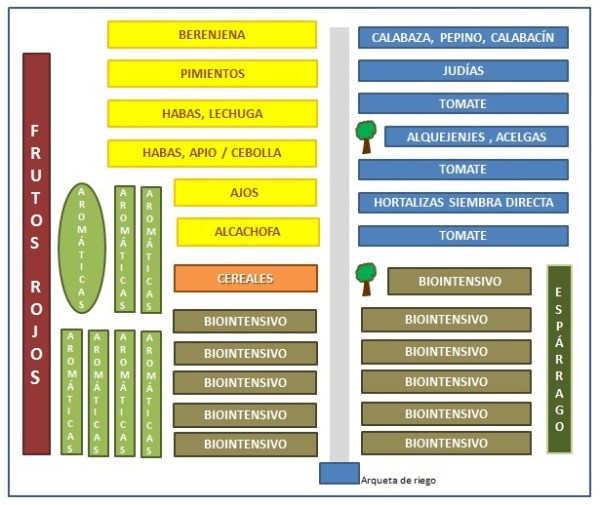 Broadly speaking, the garden can be divided into four parts:
Broadly speaking, the garden can be divided into four parts:
- Cultivation using the Biointensive Method, a practice of Ecological Agriculture that is based on the deep preparation of the soil so that more can be cultivated in less space, since the roots develop more deeply and less horizontally.
- Cultivation in terraces. They have experimented with raised beds like the ones in the photo of the pink ribbons (made with wooden pallets, ceramic tiles…) and “normal” beds, at ground level, like these:

- Flowers, aromatic and medicinal plants (on the map, green terraces): honeydew, nasturtium, thyme, oregano, tansy, milk thistle… Many of them have been chosen for their effectiveness in repelling pests.
- Red fruits: strawberries, blueberries, currants, blackberries…
The harvest of each of the terraces and the tasks of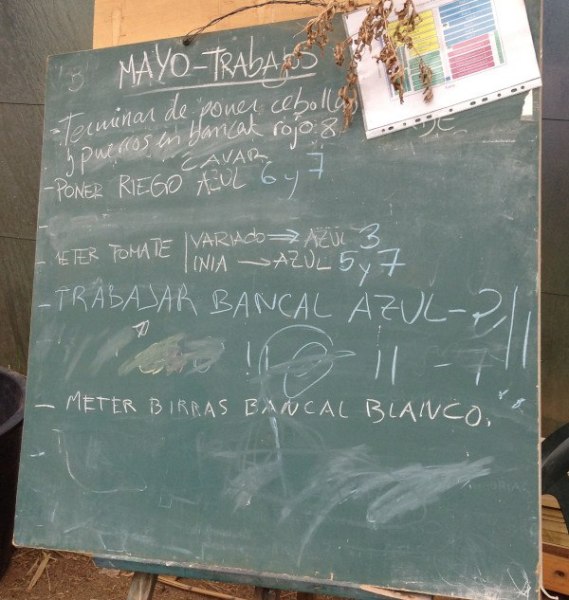 cultivation are planned and organized monthly in a meeting in which the gardeners who can/want participate, and, in order not to get involved, they use a blackboard where everything agreed is reflected.
cultivation are planned and organized monthly in a meeting in which the gardeners who can/want participate, and, in order not to get involved, they use a blackboard where everything agreed is reflected.
The crop rotations of the different terraces are also planned at the beginning of each season, a basic technique of Ecological Agriculture.
As in other community gardens, the harvest is distributed among all the gardeners and work groups that participate in HuertAula, and is also used for the annual meals or meetings that they organize.
More about ecological management in HuertAula: compost
In addition to the use of organic seeds, the restriction of the use of pesticides, the planning of rotations or the use of plants that help us fight against pests and diseases, other basic ecological practices are carried out such as the manufacture and use of compost and vermicompost.
We have already told you about these techniques in other articles in the “How to cultivate a garden” category, so I will only tell you the most outstanding and “new” things that they do in HuertAula:
1. To screen the compost more comfortably, they use this useful structure made by themselves, on which they hang the screen and the fine compost falls into a large container placed just below.

2. They water the compost heaps with urine!!
Watering the compost is a mandatory action so that the compost forms well and maintains adequate humidity, but if, in addition, it is done with this liquid rich in nitrogen and free of pathogens, its nutrient content is increased while we we dispose of this waste product. For this reason, in HuertAula they have built a small urinal (click on the photo to see it better) in which the urine is collected in bottles that are then used to water the compost.
I hope this post has been useful to you and that you use these new tricks for your gardens.

![Photo of What diseases and pests attack the cherry tree? [Identify and Treat]](https://www.complete-gardening.com/wp-content/uploads/2022/08/what-diseases-and-pests-attack-the-cherry-tree-identify-and-treat-390x220.jpg)
![Photo of Apple Tree Diseases and Pests: [Identification and Treatment]](https://www.complete-gardening.com/wp-content/uploads/2021/06/qué-necesitamos-para-sembrar-un-manzano-390x220.jpg)
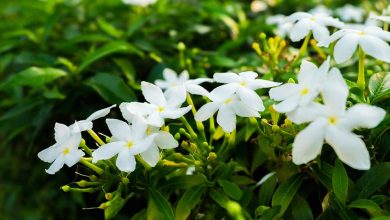
![Photo of The 20 Most Common and Beautiful Edible Flowers: [Complete Guide]](https://www.complete-gardening.com/wp-content/uploads/2022/08/the-20-most-common-and-beautiful-edible-flowers-complete-guide-390x220.jpg)